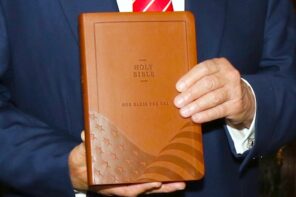Super Tuesday and the success of Donald Trump among evangelicals have caused otherwise sensible observers to once again declare the religious right to be dead. As in the past, reports of its death have been greatly exaggerated.
Religion scholar Mark Silk claims that the plurality of support from evangelical Christians for the thrice married, twice divorced, Donald Trump on Super Tuesday was just a mercy killing because the Religious Right “was moribund,” and had been “an invalid for a decade.”
Among the reasons for this, according to Silk, are that the Christian Coalition in its heyday in the 90s famously distributed millions of paper voter guides in church parking lots, but that “this kind of thing” is now only happening in Iowa. The fact is, lots of Christian Right organizations have developed considerable electoral capacity nationally and in all parts of the country, and issue voter guides, both paper and electronic, or promote those of others, including AFA Action, FRC Action, American Renewal Project, and many more.
It has created a vast array of institutions, including colleges, universities and law schools, media outlets and new political organizations which have developed sophisticated web based tools for both targeted electoral outreach as well as casting a wide net. They’ve been used by many conservative and Christian Right organizations in recent election cycles, including the American Family Association, Family Research Council, Citizen Link (the national political arm of Focus on the Family), Vision America, and Ralph Reed’s Faith and Freedom Coalition.
Indeed, the Christian Right didn’t die in 2007 with Jerry Falwell, whose Moral Majority actually went moribund in the 1980s, or with the Christian Coalition which lost its steam and leaders in the late 90s. The Christian Right was never limited to these important figures and organizations. What’s more, the structure, organizations, leaders and tactics of the Christian Right have evolved, and a variety of new organizations have risen to take their place.
Longtime political operative David Lane, for example, has been organizing all expenses paid conferences for clergy called Pastors Policy Briefings for years, featuring ambitious Christian Right pols like Huckabee, Santorum, and Cruz. He knows that building a movement is not solely about the fortunes of any one pol, issue, or election season. Among other things, he is now systematically recruiting conservative clergy to run for office at any and all levels.
The Christian Right has, in fact, never been united around a single presidential primary candidate, with the sole exception of George W. Bush, who ran unopposed for reelection in 2004.
The uniqueness of the Trump phenomenon notwithstanding, it’s unsurprising that some on the Christian Right support him, despite everything. John McCain and Mitt Romney, to cite the obvious examples, were supported through the primaries by elements of the Christian Right even though their political and religious records were at odds with much of what conservative evangelicalism is about. We also sometimes forget that the thrice married, adulterous, pro-choice, pro-LGBTQ rights, former New York mayor Rudy Giuliani was supported by Ralph Reed in 2012, and by Pat Robertson in 2008.
The fact is, there are no doctrinally or politically pure candidates—and Christian Right leaders and followers don’t necessarily agree with one another, or share the same personal or institutional ambitions in any case. This can make coalition politics difficult. When the antiabortion PAC Susan B. Anthony’s List issued an anybody-but-Trump Open Letter before the Iowa caucus, they didn’t endorse a candidate, they simply urged people to find someone else. Similarly, neo-conservative Catholic leaders Robert P. George and George Weigel’s call to arms simply urges fellow Catholics to pick any other Republican. As with any other religious or political movement Christian Right unity is often aspirational.
CNN’s Daniel Burke went so far as to state “For years, journalists have been writing the religious right’s obituary, only to see the movement rise from the grave during general elections and rally behind the GOP’s presidential candidate. But the religious right has never seen a hammer quite like Trump, and on Super Tuesday he finally nailed the coffin shut.”
In order to arrive at a conclusion like this, one has to ignore the reality of this powerful movement beyond the temporarily hard to explain bump in the conventional wisdom whose name is Trump. The Christian Right is a complex religio-political movement that has moved beyond its founding generation of individuals and organizations. In many ways it has been institutionalized for more than a decade, and remains a dynamic and apparently permanent part of the religious, political and cultural structure of modern America. Even if Trump emerges as the GOP candidate, and even if part of the Christian Right cannot rally behind him, there is no indication that this alone would dissolve the bonds. Especially when one considers the unity they would find in opposing a President Clinton or a President Sanders.
By the same standard, just because the Religious Right has not managed to get Roe v. Wade overturned and that marriage equality is the law of the land, their political activism is not diminished so much as redirected. There will be many battles in the culture war. Many of these are now largely, although not entirely in the states, and the issues are often recast as matters of religious liberty. In fact, as FiveThirtyEight recently noted, “Mentions of ‘religious,’ ‘religious liberty’ and ‘religious freedom’ appeared more than ever in this year’s debates when referring to the rights of business owners to refuse services to gay customers.”
The strength and resilience of the Christian Right does not much rise or fall based on the vagaries of presidential politics. No other major movement in American history has been so narrowly and inaccurately measured.




